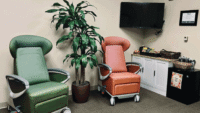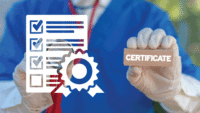Are nurse leaders serving as good examples of self-care?
- Nurse leaders must advocate for clinical nurses’ self-health and develop and support programs to ensure a healthy work-life balance for today’s workforce.
- All nurses lead, whether formally or informally, so they have responsibility modeling healthy lifestyles and self-care.
As the largest category of healthcare professionals, nurses can play a critical role in tackling public health crises and providing education. However, the National Academy of Science, Engineering, and Medicine’s (formerly the Institute of Medicine) third major report on the future of nursing states that nurses continue to face challenges in practicing self-care and maintaining their health as a result of work and environmental factors such as stress, high-demand, and long working hours. The report supports the need for an improved focus on reversing the global phenomenon of poor health of nurses, including nurse leaders who serve as primary decision makers throughout the healthcare continuum and act as role models for nursing teams.
The Future of Nursing 2020-2030: Charting a Path to Achieve Health Equity states that the improved health of the nursing workforce requires both the individual’s will to engage in self-care behaviors and the support of organizational and systemic stakeholders. Although nurses have knowledge of health promotion activities and should act as role models, studies show that this doesn’t always translate into self-care. Empowering and supporting individual nurse leaders in self-care will in turn help them promote and encourage the health of team members and clients in all healthcare settings. Self-care promoting agendas tailored to the specific needs of nurse leaders may represent a significant and cost-effective approach to building a sustainable and healthy nursing workforce. (See Healthy recommendations.)
Healthy recommendations
Weekly recommended levels of exercise vary based on age and ability, but the U.S. Department of Health and Human Services advises at least 150 minutes of moderately intense or 75 minutes of vigorous aerobic exercise per week. The Centers for Disease Control recommends 7 to 9 hours of sleep per day.
Nurses may sometimes fail to engage in healthy behaviors, but the environment in which they work may contribute to these poor choices. Some types of hospitals and specific departments or units may be more adept at supporting nurse health.
Our goal
We performed secondary analyses to examine differences in health risk and health behaviors, specifically self-care behaviors of nurse leaders based on workplace characteristics. We measured the health risk of the nurse leader through self-reported body mass index (BMI) and self-care (participation in healthy work programs and minutes of exercise performed per week).
Our approach
This descriptive study used convenience sampling to examine results from the HealthyNurse® survey administered by the American Nurses Association (ANA) within the Healthy Nurse, Healthy Nation™ (HNHN) community from May 2017 through December 2018. Our secondary analyses received internal review board approval through Case Western Reserve University’s Frances Payne Bolton School of Nursing as a joint agreement between the school and ANA. The first analysis examined the relationship between nurse leaders (n = 427) and hospital characteristics; the second examined the relationship between nurse leaders (n = 516) and their departments or units. We defined nurse leader as an RN or advanced practice RN who actively works in a nursing leadership or management position.
We measured the relationship of health risks and behaviors by work factors using bivariate analyses such as t-tests, ANOVA, and chi-square tests. Work factors included hospitals with Magnet® designation and those without, U.S. geographic region, and unit type. Geographic location was identified based on the participant’s selection of state-based nursing association or organization membership. We separated unit type into five categories: acute/critical care, ambulatory/outpatient, emergency department (ED), medical/surgical, and perioperative/post anesthesia. We measured health risk based on BMI. Although BMI isn’t a complete diagnostic measure, the Centers for Disease Control and Prevention (CDC) states that it can be used as a quick screening tool for health risk and obesity. Self-care behaviors included participation and training in organization-based health and wellness programs, hours and rigor of exercise per week, and hours of sleep per day.
Our findings
Results indicate that nurse leaders have significant health risks. Most of the participants (71.2%) fell into the overweight/obese category, and only 43% participated in healthy work programs. In addition, 63% of nurse leaders from this sample didn’t meet the CDC recommendations of 150 minutes of moderate or 75 minutes of vigorous activity weekly and muscle strengthening exercise twice per week. Approximately 46.6% of respondents reported sleeping 6 hours or less in a 24-hour period, which is below CDC recommendations. These findings contribute to the argument that the increased health affects not only nurses but nurse leaders.
Bivariate analysis showed no statistically significant difference in BMI and specific health behaviors of nurse leaders when examining a hospital’s geographic location within four U.S. regions. A CDC study revealed the existence of regional differences in health, so we were surprised to find no significant difference among nurse leaders by region. Findings indicate that all nurse leaders, regardless of location, need support to maintain health and healthy behaviors.
Our study also showed no difference in the BMI of the nurse leaders when comparing hospitals with and without Magnet designation. However, we did find that nurse leaders who work in Magnet-designated facilities participate in health behaviors more than those who work in facilities without this designation. This finding isn’t surprising. American Nurses Credentialing Center’s Magnet Recognition Program® strives to create support structures that drive positive improvements for teams, patients, families, and communities.
Nurse leaders working in ambulatory surgery and ED settings had the highest prevalence of never engaging in vigorous exercise, with only 27% engaging twice per week. Nurse leaders who work in acute/critical care, ambulatory/outpatient, ED, medical/surgical, and perioperative/post anesthesia had an average BMI of 29.1, which falls into the overweight category.
Our limitations
Limitations exist within the secondary analyses. The HealthyNurse survey was distributed through the HNHN community, which may have created a limited representation of all nurses and nurse leaders. The questionnaire relies on individual self-reporting, so the potential may exist for false identification of lower or higher health risk (for example BMI) and a false or heightened sense of participation in health behaviors.
The analyses also showed that only a subset of nurses and nurse leaders engage in the HNHN platform. Participants were 87% female and 80% white (with at least 10 years of nursing experience), creating a lack of generalizability and highlighting that the new representative generation of nurses and nurse leaders isn’t effectively prioritized or engaged.
In addition, the sample of nurse leaders wasn’t large enough to examine the differences among more stringent separations of U.S. regions. The CDC separates the country into ten regions to identify differences in health and outcomes; the sample size of nurse leaders included in the secondary analysis limited the regions to four. Limitations also exist within the HealthyNurse survey related to identification of practice setting geographical location.
Future surveys should include the option to identify the state of residence in addition to membership in a state nursing organization. The health risk questionnaire created by ANA is robust but fails to include more specific categorizations that could potentially explore the differences in health organizations (for example, academic medical centers and ambulatory centers). Going forward, limited/moderate and vigorous activity should be evaluated together, which will prove useful when comparing responses with CDC recommendations. Our data set couldn’t capture whether a participant responded yes to both limited/moderate and vigorous exercise.
Our recommendations
Nurse leaders have the potential to act as healthy role models for their teams. However, most of the nurse leaders in this study failed to demonstrate consistent self-care behaviors. ANA launched HNHN with the goal of improving nurses’ health and well-being and guiding them to be more effective role models. ANA should continue this study of the health of nurses and nurse leaders related to the work environment by making changes to the HNHN questionnaire.
For example, including state of residence and more specific healthcare settings can help reveal differences by region and work environment. Providing an option to “select all that apply” when asked about exercise will allow for more nuanced evaluation of this metric. In addition, the study must focus on engagement and retention within the HNHN platform and ensure the implementation of efforts to include a diverse workforce for necessary improvements in the nursing community at large.
Additional research can help identify how to implement and how to measure the health and health behaviors of nurse leaders. No direct link has been found between self-care promotion and healthcare work environment (hospital characteristics, classification or size of organization, academic affiliation, region/socio-economic/location demographics). This finding supports the need for more in-depth research to identify the correlation between health behaviors and work environment. Financial and operational concerns exist with regard to implementing any new program within a healthcare organization, so research should address this dilemma.
Beyond examining the most successful activities or initiatives in promoting self-health, future studies also should identify facilitators and barriers to engaging in healthy behaviors. As the effects of the COVID-19 pandemic on the healthcare workforce continues to evolve, we should measure the mental and emotional health of nurse leaders using peer-reviewed scales such as the Generalized Anxiety Disorder-2, Patient Health Questionnaire-2, or the Primary Care-Post-Traumatic Stress Disorder-5.
Shared responsibility
Nurse leaders must advocate for clinical nurses’ and their own self-care while developing and supporting programs to ensure a healthy work–life harmony for today’s workforce. All nurses lead, whether formally or informally, so we all share the responsibility of leading by example for the improved health of all nurses.
Peter Stoffan is the Magnet® Program Director at NewYork-Presbyterian/Morgan Stanley Children’s Hospital in New York City, New York. Kerri Hensler is director of nursing, perioperative services at New York-Presbyterian Hospital. Joyce Fitzpatrick is the director at Marian K. Shaughnessy Nurse Leadership Academy at Case Western Reserve University, Frances Payne Bolton School of Nursing in Cleveland, Ohio. Grant Pignatiello is an assistant professor at Case Western Reserve University, Frances Payne Bolton School of Nursing. Alison F. Cuccia is research and program manager at the American Nurses Association in Washington, DC. Linda Everett is a professor at Marian K. Shaughnessy Nurse Leadership Academy, Case Western Reserve University, Frances Payne Bolton School of Nursing. Stephanie Nolan is the chief nursing officer at Providence St. John’s Health Center in Santa Monica, California.
American Nurse Journal. 2023; 18(8). Doi: 10.51256/ANJ082344
References
American Association of Critical Care Nurses. Healthy work environments. aacn.org/nursing-excellence/healthy-work-environments
American Nurses Association Code of Ethics for Nurses with Interpretive Statements. Silver Spring, MD: American Nurses Association; 2015. nursingworld.org/practice-policy/nursing-excellence/ethics/code-of-ethics-for-nurses/coe-view-only
American Nurses Association. Healthy Nurse Healthy Nation. healthynursehealthynation.org
American Nurses Association. Healthy Nurse Healthy Nation year one highlights 2017-2018. Am Nurse Today. 2018;13(11):29-38.
American Nurses Association. Healthy Nurse, Healthy Nation: The first 5 years. Am Nurse J. 2023;18(4)31-41. myamericannurse.com/healthy-nurse-healthy-nation-the-first-5-years/
American Nurse Credentialing Center. ANCC Magnet Recognition Program®. nursingworld.org/organizational-programs/magnet
Carpenter H. Learn about the five constructs of the healthy nurse. Am Nurse Today. 2013;8(12). myamericannurse.com/learn-about-the-five-constructs-of-the-healthy-nurse
Centers for Disease Control and Prevention. Body mass index. June 3, 2022. cdc.gov/healthyweight/assessing/bmi/index.html
Centers for Disease Control and Prevention. How much sleep do I need. September 14, 2022. cdc.gov/sleep/about_sleep/how_much_sleep.html
Centers for Disease Control and Prevention. Physical activity for a healthy weight. September 14, 2022. cdc.gov/healthyweight/physical_activity/index.html
National Academies of Sciences, Engineering, and Medicine. The Future of Nursing 2020-2030: Charting a Path to Achieve Health Equity. Washington DC: The National Academies Press; 2021. doi:10.17226/25982
Nolan S, Carpenter H, Cole L, Fitzpatrick J. The HealthyNurse® Leader. Am Nurse J. 2020;15(1). myamericannurse.com/the-healthynurse-leader
Ross A, Bevans M., Brooks AT, Gibbons S, Wallen GR. Nurses and health-promoting behaviors: Knowledge may not translate into self-care. AORN J. 2017;105(3):267-75. doi:10.1016/j.aorn.2016.12.018
United States Department of Health and Human Services. Physical activity. August 25, 2021. health.gov/our-work/physical-activity
World Health Organization. Obesity and overweight. June 9, 2021. who.int/news-room/fact-sheets/detail/obesity-and-overweight
World Health Organization. Self-care interventions for health. who.int/health-topics/self-care#tab=tab_1
Key words: self-care, nurse leaders, role modeling, health advocacy

















